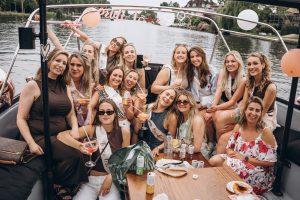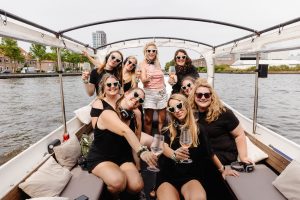Why does your explore feed end up on that dreamy island or that city break you "just happened" to have in mind? Algorithms are the internet's invisible travel agents: they know your preferences, weigh millions of signals, and then shove a shortlist of destinations in front of you. The clock is ticking. You scroll through one more video. Will you go for that photogenic square, or will you choose the secret cove?
As a travel strategist and content creator, I've seen it firsthand: a single Reels video about Cappadocia sent a small B&B's inbox full within two weeks. This wasn't a coincidence; it was due to ranking factors like watch time, interactions, and relevant hashtags that the algorithm "trusted." In this article, we'll unravel step by step how these systems work, why they stimulate our brains so effectively, and how you can use these recommendations more intelligently (and consciously).


What are social media algorithms and how do they work behind the scenes?
Algorithms on social platforms are recommendation systems that determine which posts, videos, and Stories you see. Technically, they rely on a pipeline of candidate retrieval (quickly retrieve thousands of possible posts), ranking (score each item based on the likelihood that you will appreciate it) and re-ranking (balancing relevance, diversity, and safety). For example, Instagram describes a multi-layered funnel for Explore using neural networks, including two-sided "Two-Tower" models, to predict user-content matches (Meta Engineering, 2023). (Instagram, 2023; Meta Engineering, 2023). :contentReference[oaicite:0]{index=0}
TikTok's For You feed and YouTube's recommendations operate on similar principles: a mix of signals such as watch time, rewatch time, full-screen viewing, interactions, device and account settings, and content characteristics (e.g., sound, hashtags, captions). TikTok identifies three clusters—user interactions, video information and device/account settings—whose weight shifts dynamically. YouTube confirms that viewing and search history, subscriptions, and likes influence subsequent video viewing, supported by deep learning (Covington, Adams & Sargin, 2016; TikTok, 2020; TikTok Support, 2022; Google/YouTube Support, 2025). :contentReference[oaicite:1]{index=1}
At a glance
| Term | Core meaning | Why it matters for travel content |
|---|---|---|
| Watch time | How long someone watches | Long viewing time = strong “quality signal” → more reach |
| Dwell time | How long you stay at a post | Indicates that a destination is interesting → extra distribution |
| CTR | Click-through rate on video/post | Strong title/thumbnail of a destination wins the feed |
| Interaction | Likes, comments, shares, saves | Social proof elevates destinations to trending |
Want to make it practical? Try this:
- Review your last 10 travel posts and note watch time, click-through rate, and retention.
- Compare formats (vlog, guide, cinematic) with performance per platform.
- Republish your top-performing videos with a new hook and subtitle.
Why do algorithms influence our travel preferences and destination choices?
Because they optimize for attention, not for objective completeness. Travel suggestions that reflect your previous behavior to confirm immediately feel "right". That's what it's called relevance optimization: Systems learn from your micro-signals—pausing on a drone shot, commenting on “hidden gems,” saving a food map—and scale similar content. The result? Your feed becomes a personal showcase where Santorini, the Dolomites, or Kas return again and again, because the data predicts you'll be drawn to them (Instagram, 2023; Google/YouTube Support, 2025). :contentReference[oaicite:2]{index=2}
In addition, behavioral incentives play a role: intermittent rewards (every scroll can give a “wow” moment), herd behavior (others seem to be going, so you too) and heuristics Such as, "Whatever's been shared a lot must be good." Research in the travel industry shows that social content often triggers immediate decisions: 62% of social media users who view travel content made a specific choice after seeing that content (Phocuswright, 2024). Think of booking a boutique hotel after a viral TikTok tour. (Phocuswright, 2024). :contentReference[oaicite:3]{index=3}
Recommended internal links (non-clickable, for WordPress editor):
- Guide to “Keyword Research for Travel Blogs”
- UGC Guidelines & Rights Guide for Travel Content
- Preventing Overtourism: Practical Tips for Conscious Travelers
How do trending hashtags and viral content influence our travel behavior?
Hashtags and trending audio serve as highways in the distribution network. They give the algorithm semantics: #eurotrip, #hiddenbeach, #slowtravel. Combine that with a format that engages viewers—fast cuts, pattern interrupts, clear text layers—and you increase the chances of your video surviving the initial "test audience" round and moving on to larger cohorts. TikTok explicitly describes how ranking factors combined with user signals shape the For You feed, including adjustments for what you don't like. (TikTok, 2020; TikTok Support, 2022). :contentReference[oaicite:4]{index=4}
My own test: a short video "48 hours in Naples" with #pizzanapoli and #citybreak barely got any views… until I changed the hook to "You'll miss this pizzeria if you're not paying attention" and made the first three seconds more visually engaging. Watch time jumped from 14% to 42%, and the post landed on Explore. Instagram explains that it first aggregates posts, then ranks and re-ranks them based on expected interest; so a small difference in retention can be the tipping point (Instagram, 2023; Meta Engineering, 2023). :contentReference[oaicite:5]{index=5}
What role do platforms like Instagram, TikTok and YouTube play in travel decisions?
Instagram is the showcase: visually strong, ideal for “wishlist” destinations via Reels and Explore. TikTok is the discovery machine: quick, raw tips, hotspots per neighborhood, and unexpected gems thanks to the For You mechanism. YouTube is the planner: longer videos, directions, cost overviews, and deep dives—powered by a recommendation engine that uses deep learning to select and rank candidates based on predicted watch time and satisfaction (Covington, Adams & Sargin, 2016). (Instagram, 2023; TikTok, 2020; Covington et al., 2016). :contentReference[oaicite:6]{index=6}
In concrete terms, this means you often go through a "inspiration → intention → planning" hybrid. A trending TikTok about the Algarve sparks desire, an Instagram collection of saved posts refines your shortlist, and a YouTube video "10 mistakes to avoid in Lagos" seals the deal. YouTube confirms that viewing and search history, as well as similar user patterns, drive recommendations—useful for binge-ready "best of" playlists about a single destination (Google/YouTube Support, 2025). :contentReference[oaicite:7]{index=7}
Platform signals vs. travel formats
| Platform | Key signals | Best formats for travel | Typical outcome |
|---|---|---|---|
| Dwell time, saves, shares | Reels with hook + overlay text | Explore reach and wishlist storage | |
| TikTok | Full viewing time, rewatch, interaction | Snappy tips, neighborhood guides, POV | Unexpected discovery, rapid viral spikes |
| YouTube | Average watch time, session time, CTR | Itineraries, budget guides, do's & don'ts | Deep intention, long sessions, booking decisions |
How do likes, shares, and comments determine which destinations become visible?
In a nutshell: interactions are proxies for expected satisfactionSystems learn that posts that are shared frequently are more likely to be relevant to similar profiles. Saves and shares are often considered stronger signals than likes because they reflect intent ("I want to save/forward this"). TikTok and Instagram confirm that user interactions are highly relevant to ranking; YouTube also prominently cites the role of watch and search history (TikTok, 2020; Instagram, 2023; Google/YouTube Support, 2025). :contentReference[oaicite:8]{index=8}
For travel content, this creates a snowball effect: a high-retention video about "The 5 Most Beautiful Miradouros in Lisbon" gets more impressions; more impressions generate more micro-interactions; more interactions signal value; and so the ball rolls. As a creator or DMO, you can leverage this ethically by divisible Building assets (mini-maps, budget breakdowns). As a traveler, it's smart to consciously "reset" your feed sometimes (different searches, unknown creators) to get out of your bubble (Google/YouTube Support, 2025; TikTok Support, 2022). :contentReference[oaicite:9]{index=9}
Which signals often carry the most weight?
| Signal | Typical weight | Impact on destination visibility |
|---|---|---|
| Full watch time/retention | High | Rapid scale-up to larger audience pools |
| Saves & shares | Mid-high | Additional distribution to lookalike target groups |
| Comments (qualitative) | Middle | Signal of engagement; triggers further distribution |
| Likes | Middle-low | Supportive; mainly count in volume |
Quick audit checklist
- Is the first 3–5 seconds of your video irresistible?
- Does your caption provide context (cost, route, best time) to encourage saves?
- Do you end with a question that elicits quality comments?
Which psychological factors make us susceptible to algorithmic influence?
First up: FOMO—the fear of missing out. Research shows that FOMO is linked to higher social media engagement and lower satisfaction; it’s no wonder, then, that countdowns (“Northern Lights season ends in 3 weeks!”) are more likely to make you book (Przybylski et al., 2013; Gupta, 2021). Combine that with platform design that offers constant rewards, and you get a potent cocktail for impulsive travel decisions. (Przybylski, Murayama, DeHaan & Gladwell, 2013; Gupta, 2021). :contentReference[oaicite:10]{index=10}
Second: availability bias and social proofIf you saw #AmalfiCoast 12 times in the past week, that destination seems more "logical" than a less shared but equally beautiful region. Industry data shows that social content often drives concrete decisions (Phocuswright, 2024). And honestly, who's immune? I once spontaneously booked a night at an eco-lodge after seeing the same timelapse of stars over the desert three times—exactly the kind of images algorithms love to highlight. (Phocuswright, 2024). :contentReference[oaicite:11]{index=11}


How do social proof and FOMO affect our travel plans?
Social proof acts like a buzz barometer: numerous saves and shares make a location feel "safe and worthwhile," which removes barriers. FOMO pushes you over the edge, especially during seasonal highlights (blossoms, auroras). Platforms reinforce this through engagement-driven ranking: a snowball that keeps rolling as long as the reactions are positive (TikTok, 2020; Instagram, 2023). :contentReference[oaicite:12]{index=12}
Want to stay mindful of your choices? Consider micro-rules that "detoxify" your feed:
- Also consciously follow small, local guides and diverse regions.
- Pause or clear watch/search history periodically.
- Compare social tips with independent sources and official DMO information.
YouTube offers settings to pause watch and search history; TikTok lets you mark yourself as "Not Interested"—useful for recalibrating recommendations (Google/YouTube Support, 2025; TikTok Support, 2022). :contentReference[oaicite:13]{index=13}
Why do we trust visual content more than written recommendations?
Images stick. The so-called pictorial superiority effect shows that people understand and remember images faster than words—an advantage that has been demonstrated repeatedly in health communication and is also reflected in marketing (Houts et al., 2006; Schubbe et al., 2020/2018). For travel content, this means that a 5-second shot of an azure bay can be more persuasive than 100 words of text. (Houts, Doak, Doak & Loscalzo, 2006; Schubbe et al., 2018/2020). :contentReference[oaicite:14]{index=14}
But beware: what looks convincing isn't automatically representative. Wide-angle lenses, color grading, and clever cuts can distort expectations. My tip: look for creators who demonstrate transparency (prices on screen, crowd level at noon, alternative routes). And as a publisher, you can build trust by adding context boxes (best time to travel, environmental impact, accessibility)—so the viewer gets more than just aesthetics.
::contentReference[oaicite:15]{index=15}
How do travel companies and influencers use algorithms to promote destinations?
Travel agencies and influencers are leveraging algorithms as a marketing engine. They understand that platforms like Instagram and TikTok optimize behavior for attention and engagement, and they adapt their content strategies accordingly. Think of video lengths that perfectly align with the retention sweet spot or the clever use of trending audios that increase the chance of a destination going viral. According to Statista figures (2024), 40% of Generation Z indicate that TikTok is their first search engine when planning a trip, demonstrating the significant role these platforms play.
Influencers also use micro-targeting through platform tools: they select target groups based on location, interests, and travel budget. Travel organizations do the same through sponsored posts that target specific user segments. With data-driven storytelling They respond to search intent recognized by the algorithm, making destinations not only visible but also attractively presented. The algorithms thus become the digital "intermediaries" that make tourism marketing faster and more targeted.
What strategies do travel agencies and tourism marketing use through social media?
One of the most important strategies is the use of influencer partnershipsAgencies connect their brands with creators who already have strong engagement. This increases the likelihood that the algorithm will recognize the content as valuable and distribute it further. In addition, many organizations work with "snackable content"—short videos or carousels with strong hooks and clear calls to action. According to a Deloitte report (2023), this type of content leads to 70% higher interaction rates compared to traditional advertising.
In addition, organizations apply geo-targeting add: ads that are only shown to users who search for “summer vacation 2025” or “budget city trip Paris”. Also user-generated content (UGC) Campaigns are becoming increasingly popular, as algorithms often reward them with higher authenticity scores. By allowing travelers to share their own experiences using specific hashtags, organizations strengthen both their brand reach and their algorithmic advantage.
How do sponsored posts differ from organic travel experiences?
At first glance, the distinction is often subtle. Sponsored posts are typically labeled with tags such as #ad or paid collaboration, but in practice, these signals are often ignored by viewers. Algorithms treat both types of content based on the same core signals (watch time, interactions), but sponsored posts receive extra momentum through paid distribution. This means that even without strong organic performance, the content can still appear prominently in the feed.
Organic content often feels more authentic: personal stories, raw images, and honest opinions. Sponsored posts are usually more tightly produced and focus more on brand goals. The danger is that users sometimes lose the ability to distinguish between them. A study by the European Consumer Organisation (2023) found that 65% of users find sponsored posts difficult to recognize. This makes transparency and clear labeling crucial to maintaining trust.
What are the risks and misconceptions surrounding algorithm-driven travel choices?
While algorithms offer inspiration, they also carry risks. A major danger is the illusion of completenessUsers believe their feed provides a representative selection of destinations, when in reality, it's merely a filtered selection. Furthermore, the constant emphasis on "Instagrammable places" narrows the travel experience. Destinations that don't meet the algorithm's visual standards are underrepresented, no matter how valuable they may be.
Another misconception is that popularity equates to quality. In reality, a place can become trending because of a random viral video, without the experience actually being representative or lasting. This can lead to disappointment and a misunderstanding of what a destination has to offer.
How do echo chambers and filter bubbles affect our view of the world?
Echo chambers arise when algorithms repeatedly offer similar content based on your previous interactions. This creates the feeling that "everyone" is going to the same destination. For example, if you've liked multiple videos about Bali, your feed will likely be flooded with similar content, causing alternative destinations to disappear. The result is a one-sided worldview and a narrowing of your travel options.
Filter bubbles exacerbate this even further: they isolate you from information that doesn't align with your previous preferences. It's like receiving a travel guide that only includes chapters on places you've already considered. While this feels efficient, it actually limits your horizons and hinders the process of discovery that makes travel so valuable.
Why does algorithmic influence sometimes lead to overtourism?
Overtourism occurs when a destination attracts more visitors than it can sustainably support. Algorithms exacerbate this problem by making popular spots even more visible. A single viral TikTok about a small village can attract thousands of visitors a day, as happened in Hallstatt, Austria. There, a 500% increase in visitors over five years led to infrastructure problems and tensions with the local population.
Moreover, the algorithmic focus on "shareable spots" often leads to overconcentration: a single photogenic viewpoint attracts tourists in droves, while nearby alternatives are ignored. Without conscious policies from both platforms and travelers, this can lead to environmental damage, cultural erosion, and a lower quality of life for locals.
How can a traveler be more aware and critical of algorithmic recommendations?
Conscious travel starts with mindful scrolling. As a traveler, you can learn to thwart the algorithms by diversifying your search behavior. Actively explore new destinations outside your standard feed, for example, through travel blogs, official tourism websites, and forums like Reddit Travel. This gives you a broader perspective and helps you avoid getting trapped in a filter bubble.
It's also important to critically examine the source of the content. Ask yourself: is this a sponsored collaboration? How representative are the images? What are they not showing? By asking yourself these questions, you'll make more informed decisions and increase the likelihood of authentic experiences.
What practical tips help you find authentic travel experiences?
Authentic experiences often lie off the beaten path, but that requires active searching and critical thinking. A simple checklist can help:
- Check reviews on multiple platforms (TripAdvisor, Google Reviews, Booking).
- Find local blogs and vlogs that rely less on algorithmic rankings.
- Use alternative hashtags such as #offthebeatenpath or #slowtravel.
- Ask locals about their favorite spots via Facebook groups or forums.
- Always combine social media inspiration with practical resources such as Lonely Planet or official tourism websites.
You can also consume more consciously by resetting your own feed: delete your viewing history, consciously click on unfamiliar content, and follow smaller accounts. Just as a traveler checks their compass before embarking on a new route, you can reset your digital compass to counter algorithmic biases. This increases the chance that your journey truly becomes your story, and not just the algorithm's choice.
How can one recognize reliable sources and reviews beyond social media content?
Reliable sources are typically distinguished by transparency and consistency. While social media posts are often snapshots with emotional triggers, independent reviews allow you to focus on details: data, context, and a balance between positive and negative points. A TripAdvisor review that details the wait time for a taxi or the entrance fee is often more valuable than a TikTok video that simply shows a scenic view. Nielsen research (2023) shows that consumers still consider reviews from other travelers to be one of the most trusted sources of information, provided they are sourced from multiple platforms.
Source checking also plays a role: reliable travel blogs and official tourism websites list their information sources, update content regularly, and often include practical details like opening hours and prices. Social media posts, on the other hand, rarely receive this level of scrutiny. As a traveler, you can therefore remain critical by asking yourself: "Does this information come from one person, or is it confirmed by multiple independent sources?"
What insights do experts and experienced professionals share about this phenomenon?
Experts point out that algorithms play a dual role: they offer enormous opportunities for inspiration and visibility, but also pose risks for the homogenization of travel experiences. Research from the Harvard Business Review (2022) emphasizes that recommendation systems are primarily designed to maximize engagement, not to paint a balanced picture of the world. Tourism experts therefore advocate for awareness campaigns so that travelers understand how feeds are generated and take more control.
Experienced travelers, such as travel bloggers and local guides, often say that viral trends can have unexpected consequences. An influencer can put an unknown waterfall on the map with a single video, attracting hundreds of visitors a day. At the same time, this can lead to frustration among locals and damage to the environment. Their advice: consume responsibly and consider the impact of your travel choices. A destination isn't just a backdrop for content; it's also a habitat for people and ecosystems.
How can readers share their own experiences and questions about travel and algorithms?
Readers can contribute by actively participating in the discussion in the comments section or via the blog's social channels. This kind of exchange provides more perspectives and a richer understanding of how algorithms influence travel behavior. Sharing personal stories—for example, how someone discovered an unexpected destination through a niche YouTube video—helps others recognize and break algorithmic patterns.
It's also valuable to ask questions or address misconceptions. Why, for example, do you keep seeing the same destination in your feed? Or how can you determine if a trend is truly representative? By sharing experiences and questions, the community builds a collective knowledge base that extends beyond what the algorithm provides.
What are the key lessons and what steps can we take for conscious travel behavior?
The key lesson is that social media algorithms are powerful travel advisors, but not always the most reliable. They filter the world through a lens of attention and popularity, leading to tempting but often limited choices. Conscious travel behavior means not rejecting algorithms entirely, but combining them with independent sources and your own critical perspective.
Practical steps for more conscious travel include:
- Diversify your sources of inspiration: besides Instagram, also use travel guides, blogs, and local websites.
- Recognize sponsored content and weigh it differently than organic experiences.
- Ask yourself critical questions about the context and completeness of the information.
- Choose destinations that align with your values, not just the trends in your feed.
- Take responsibility for your impact by traveling sustainably and respectfully.
By applying these steps, you can use algorithms as a tool instead of an invisible helmsman. Ultimately, you're the one who chooses the destination—not the algorithm. And perhaps that's the greatest freedom of travel.